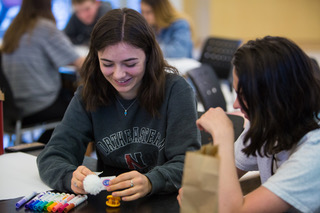When Elise Malterre decided to attend One Stone, a break-the-mold, tuition-free independent high school in downtown Boise, she and her mother had one long-term worry nibbling at the back of their minds: what about college admissions?
The school, which serves 105 students in grades 10-12, doesn’t evaluate them in any traditional way. No tests. No grades. Instead, it uses a detailed, arguably more meaningful instrument called a growth transcript, which measures students’ growth as they work toward becoming fully developed human beings. It follows their academic progress, to be sure, but also their growth in mindset, creativity, empathy, and skills ranging from goal-setting to critical thinking.

Students have come to appreciate it. Educators love it, and parents say it gives them insights into their children no report card could ever match.
“The growth transcript is truly revolutionary,” said Teresa Poppen, One Stone’s founder. “No other school is doing this. It’s pioneering work.”
But what about colleges? Would the ever-more-intense and competitive admissions process leave One Stone students marginalized? That’s what Elise and her mother Jody wondered, even as Elise thrived and blossomed at the school, developing a passion for design after entering One Stone focused on environmental issues.
They needn’t have worried. Elise, a member of One Stone’s first graduating class this spring, applied to eight schools, and was admitted to seven, including two of the top design schools in the country — Parsons School of Design in New York, and the Rhode Island School of Design in Providence, R.I.
Ultimately, she chose Parsons, which offered a generous merit scholarship. She was offered tens of thousands of dollars in such scholarships by five of the seven schools that admitted her.
“Mindset-wise I was nervous initially because it was a risk. A transcript like this was never done before,” Elise said one rainy late winter day. “As much as they told us ‘Don’t worry about it, it will be fine,’ there was still an unknown.”

Elise’s admission success wasn’t an aberration. One Stone’s seniors received admissions offers from 45 different public and private colleges and universities from coast to coast, many of them including generous merit- and need-based scholarships.
“Our students’ success with colleges will really open the gates and encourage other schools to try something similar,” Poppen said.
In this, the first year One Stone produced graduates, higher education institutions grappled with unknowns when attempting to adapt One Stone student applications to traditional admissions processes. In place of a straightforward transcript listing letter grades and a grade point average, admissions officers received the growth transcript, which provides rich information on student progress in four broad areas: Mindset, knowledge, creativity and skills.
Under each of those four categories, eight subcategories provide a granular look at students’ progress over their three years at One Stone in a bar chart format. That’s 32 data points to analyze and evaluate.
Growth transcript subcategories include traits such as empathy, grit, humility, mindfulness, vulnerability, critical reading, writing, mathematical application, scientific inquiry, curiosity, design thinking, ideation, risk-taking, passion, goal-setting, leadership, collaboration and communication.
For each of the 32 subcategories, students are assessed on a seven-point continuum ranging from emerging at the low end to mastering at the high end. The highest three-and-a-half levels are considered “equipped for college/career success.” The bar for each category moves as students exhibit and prove growth based on evidence.
“In some ways, especially with this first graduating class, One Stone has asked colleges to kind of go out on a limb for them,” said Nathan Mannetter, assistant director of admissions at Gonzaga University in Spokane, Wash. “Whenever you’re working with something that is new and different, there has to be a trust level there: trust that how One Stone is measuring these students is going to be indicative of success on our campus.”
That’s a question that won’t be fully answered for several years, Mannetter said, until One Stone students have matriculated, graduated, and embarked on the early years of their careers. But based on his knowledge of the school and its students (he has visited One Stone multiple times), he is confident students will thrive at Gonzaga.
Gonzaga admitted three One Stone students from the inaugural graduating class. “When I visited with them, I told them their biggest struggle is going to be navigating a new process, a more traditional learning environment,” Mannetter said. They’re going to have to get used to that, but they have the tools to do that because of the kind of experience they had in high school.
“They are really cool kids, and I have no doubt in my mind they will figure it out.”
Lisa Fisher, who heads up One Stone’s admissions efforts, said not all schools are as accommodating as Gonzaga. It has taken concerted effort to get some colleges to feel comfortable with One Stone’s growth transcript, and the school’s overall educational philosophy.
“It’s a brilliant model of how to take a look at kids,” Fisher said. “But we are a square peg trying to fit into a round hole. The fact is all of these colleges and universities have systems set up around this old way of assessing kids, but the more admissions officers learn about One Stone and its project-based learning turning into real-world application, the more enthused they get,” Fisher said.
As an example, she cited a group of students who developed a mobile app called Clutch, which incentivizes teens and adults not to text while driving. During the design thinking process that led to the app’s development, the Clutch team discovered that adults actually are worse about texting while driving than teens. The One Stone team won a pitch competition last spring at Boise State Venture College.They have since traveled and presented at multiple conferences and competitions,both to secure funding for their app development and to share the importance of their journey with design thinking in the real-world.
“Examples like that, of students pursuing their passions and excelling, has given admissions officers a better picture of the capabilities of One Stone students,” Fisher said. “It looks quite a bit different than getting an A on a paper or a 90 on a test.”
The growth transcript ties neatly to One Stone’s version of a curriculum which the school calls its Disruption BLOB (short for Bold Learning Objectives). The BLOB is divided into the same four categories and 32 sub-categories that populate the growth transcript.
Behind the BLOB lies One Stone’s belief that students should graduate with a range of skills that make them adaptable, resilient, creative problem solvers who understand that learning is a lifelong endeavor, and who have learned how to learn as a part of their experience, setting them up for greater success in the future.
Everything the school does, from its student-run businesses to its design thinking approach to problem solving drives toward that vision of a One Stone graduate. And as anyone who has spent time talking to employers recently knows, well-rounded candidates with strong soft skills are precisely what most organizations are looking for in new hires. Such candidates are surprisingly hard to find, especially coming out of large, comprehensive high schools, with their test- and grade-driven cultures.
School leaders say the growth transcript provides a multidimensional view of One Stone students that allows college admissions officers to get a holistic sense of applicants that is more valuable than any alternative instrument. In the school’s earliest days, just three years ago, One Stone’s team considered joining a consortium of non-traditional schools that was developing a mastery transcript that might fit more into the comfort zone of colleges and universities. Ultimately, however, One Stone decided that joining the group would require too many compromises.
“We see ourselves as uniquely, distinctly different,” One Stone Director Chad Carlson said. “And we felt confident in being able to move the needle in ways distinct to ourselves.” That required developing a cutting-edge transcript; a living document that provides a three-dimensional picture of students. One Stone educators see the growth transcript as a living document, and aspire to have other schools learn from it and adapt it for their own use.
Students have a significant amount of say in what goes on their growth transcript. One Stone coaches meet regularly with their advisees to go over the transcript, and when a student disagrees with any element of the evaluation, the coach can make adjustments. To change evaluations, student must justify their position through reference to and reflection on their portfolio, a collection of their professional and academic work.
“The student gets ultimate say in working with their adviser about where they are,” Carlson said. Notably, the most frequent adjustments occur when students perceive that their coach has rated them too highly in certain areas. “If anything, students tend to scale it back,” Carlson said.
As the first cohort of graduates leaves the school and moves on to what is next, students and educators alike express confidence about the future.
“The skills I’ve gained in this flexible setting, where you have a voice in what you are doing, have prepared me for more rigid structures,” Elise Malterre said. “I know I’ll be able to adapt to whatever situation I’m in and to advocate for myself.”
One Stone’s growth transcript poses a new and necessary challenge to higher education, Gonzaga’s Mannetter said. It’s the front edge of a wave of change that will, over the next 10 to 20 years, transform how schools evaluate students and present their graduates to admissions offices, he said.
Schools are feeling pressure to make these changes because the accelerating pace of automation and artificial intelligence, and a rapidly diversifying workforce, mean students need to graduate with deeper self-knowledge and soft skills no machine can replicate. Transcripts need to chronicle that growth, rather than providing static data like test scores and GPAs.
One Stone is ahead of everyone in rethinking transcripts. That’s helpful to colleges, because it gives them a sneak preview of what’s to come, and a heads-up that it’s time to start preparing now for a sea change.
“In 20 years there will be a lot more schools doing what One Stone is doing than what traditional high schools do today,” Mannetter said. He concluded wryly that “this is terrifying to those of us in higher ed who have to figure out what the hell to do with that.”
Disclosure: One Stone and Idaho Education News are funded by grants from the J.A. and Kathryn Albertson Family Foundation. Writer Alan Gottlieb is a board member and vice chair for Idaho Education News.
